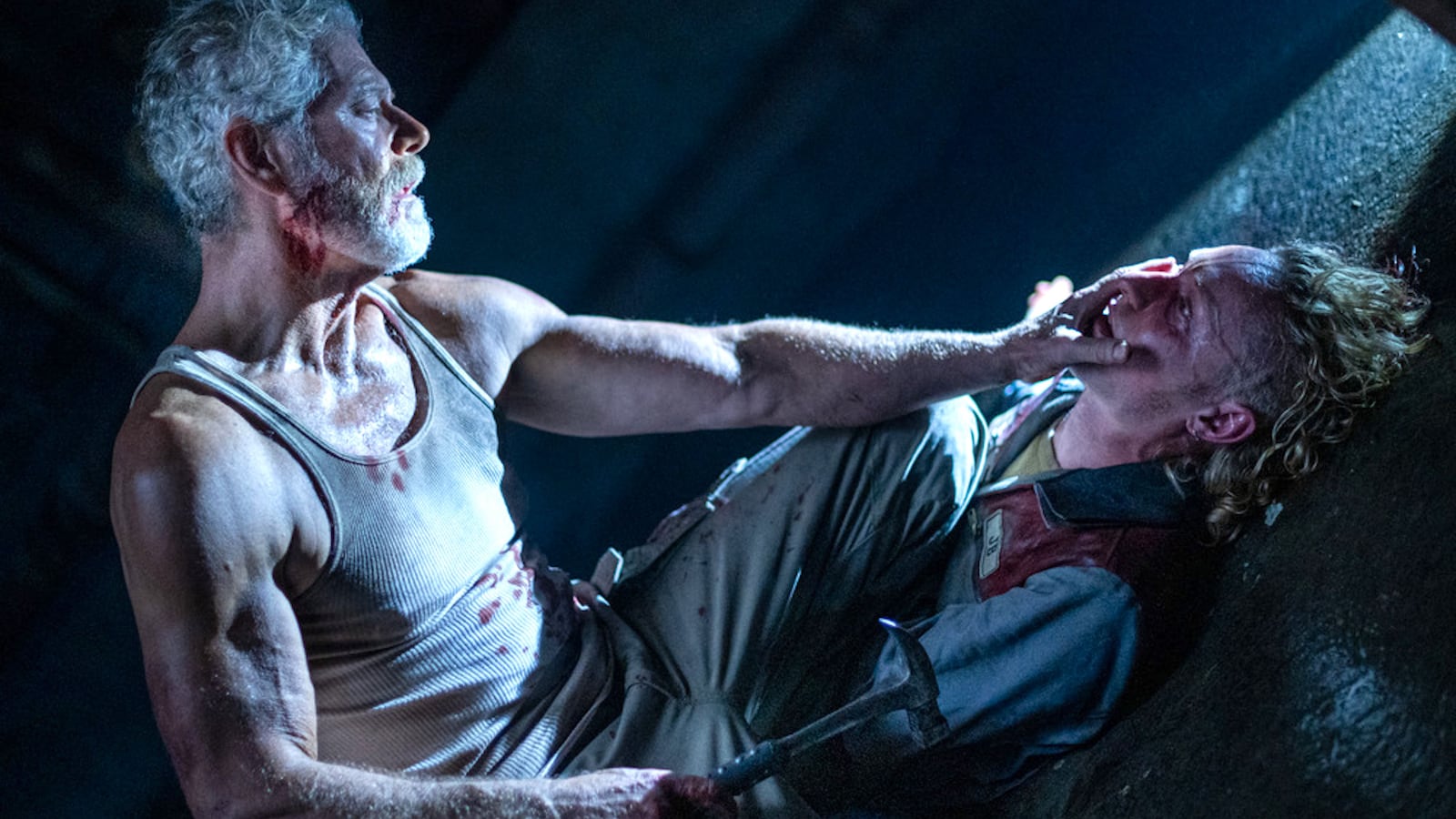Much of Don’t Breathe’s superb suspense came from director Fede Álvarez’s ability to play with his audience’s identification with—and sympathy for—his characters: a trio of thieves desperate to steal money that would allow them to escape their hardscrabble Detroit lives, and the blind war vet Norman Nordstrom (Stephen Lang) whose cash (earned from a settlement over his daughter’s untimely death) they sought. Everyone in Álvarez’s 2016 thriller was both a victim and a victimizer, which complicated—at least for a time—one’s rooting interest in their plights. That said, by film’s end, it was easy to ID the real villain, given that Norman was revealed to be a psychotic rapist intent on impregnating his daughter’s (accidental) killer with a dripping-wet sperm-loaded turkey baster.
Which therefore begs the question: what in the holy hell is Don’t Breathe 2 (in theaters Aug. 13) doing making Norman its indisputable hero?
Like its predecessor, first-time helmer Rodo Sayagues’ sequel (co-penned with Álvarez) is interested in constantly upending one’s allegiance to its main players. The problem, however, is that from the get-go, it also makes clear that it’s on the side of Norman, who’s now elevated to protagonist status alongside his young daughter Phoenix (Madelyn Grace). An eight-years-earlier aerial shot of Phoenix collapsing on a street near a burning house is one of many shout-outs to the prior film, and immediately suggests that she’s come into Norman’s possession through unnatural means. Then again, since Norman has already been established as a monstrous sexual predator intent on procuring himself a new child, the initial mystery isn’t whether the now-11-year-old Phoenix has been abducted, but under what particularly shocking circumstances that crime has taken place.
While Norman’s new house is bigger than his last, it’s still a remote, dilapidated abode unfit for raising kids, and Don’t Breathe 2 spends its early passages concisely conveying Phoenix’s misery over her shut-in, home-schooled situation. A rare trip to town with Hernandez (Stephanie Arcila), an Iraq War vet who sells Norman’s plants—thereby providing him with some income—gives Phoenix a glimpse of normal childhood, via boys and girls on a playground outside a local convent. It also leads to a store bathroom encounter with Raylan (Brendan Sexton III), a grungy stranger whose malevolent intentions are thwarted only by the appearance of Phoenix and Norman’s frightening dog Shadow. Could Raylan be involved with the creepy doctor that news reports indicate is operating a nefarious organ-trafficking ring? The cooler in the back of his pick-up truck suggests yes!
Don’t Breathe 2’s opening setup is akin to John Wick, with cocky thugs intimidating people in public, and then responding to rejection by staging an angry payback-style home invasion, only to discover that their intended target is more fearsome than expected. The catch, however, is that in this instance, Norman is John Wick, which makes no sense in light of our knowledge of his violent-insemination past. Nonetheless, Don’t Breathe 2 soldiers on, orchestrating a number of gruesome skirmishes between sightless Norman—whose other senses are superhero-level formidable—and his ex-military adversaries, including one hammer-wielding mercenary (Adam Young) with blond hair that’s long in the back and shaved on the sides for maximum degenerate-lunatic energy.
Sayagues follows in the footsteps of his creative partner-in-crime Álvarez by orchestrating a protracted and virtuoso single-take shot that, here, follows Phoenix around her bedroom, upstairs hallway, and downstairs foyer as she silently evades her pursuers. Sayagues’ direction is silky and serpentine, and he douses his action in hungry shadows that swallow up, and regurgitate back out, lunging and furious figures. The sight of Norman suddenly emerging from the dark to grab his enemies becomes a familiar one, and those images—along with a late sequence in which Norman gears up for battle—cast him as a veritable Batman. With a gravelly voice and a brawny physique, Lang more than fits that part, but again, it’s impossible to reconcile this portrait of Norman with the basic reality that he’s a rapist who years earlier tried to brutally shoot his semen into a bound and gagged woman with a cooking utensil.
It’s difficult not to harp on the sheer absurdity of pivoting Don’t Breathe 2 around Norman’s role as laudable protagonist, and though Sayagues and Álvarez’s script eventually flips its dynamics a bit—courtesy of revelations about Raylan and company that are supposed to make their conduct appear justified—the gesture is disingenuous, as evidenced by even later bombshells that reaffirm the introductory status quo. With bruising, menacing intensity, Lang does his best soulful-hulking routine. Yet the desire to paint Norman as simply a confused, grieving dad is as laughable as the finale’s stabs at affording him redemption, and no amount of glib nonsense—such as Hernandez calling Norman “a bad man” and then excusing it as a natural symptom of wartime duty and guilt—can make it all go down easier.
Twisting itself in knots in order to keep viewers on their toes, Don’t Breathe 2 ultimately winds up more or less right where it began, and just as frustrating is the fact that the journey to its predictable conclusion is sorely lacking in tension. Whereas the first film was a rigorously confined, efficient affair marked by a small claustrophobic setting, a few unlikable characters and a straightforward plot, Sayagues’ follow-up proves the age-old maxim about more being less. Instead of lean and mean, it’s rollercoaster-frenzied, piling on superfluous backstory and ho-hum showdowns to reduced impact, as well as throwing in a few grisly bits to provide a temporary jolt.
By the time it lays all its cards on the table, Don’t Breathe 2’s slipshod writing has already taken a nosedive into clunkiness. The material fleetingly seems on the precipice of saying something interesting about the intertwined relationship between birth and death, and the alternately ugly and beautiful bond shared by parents and children—notions that feel related to two separate shots of vaginal-shaped gushing-blood wounds. But by and large, Sayagues’ film is merely a misguided attempt at continuing a series that would have been wise to stop breathing after one installment.


